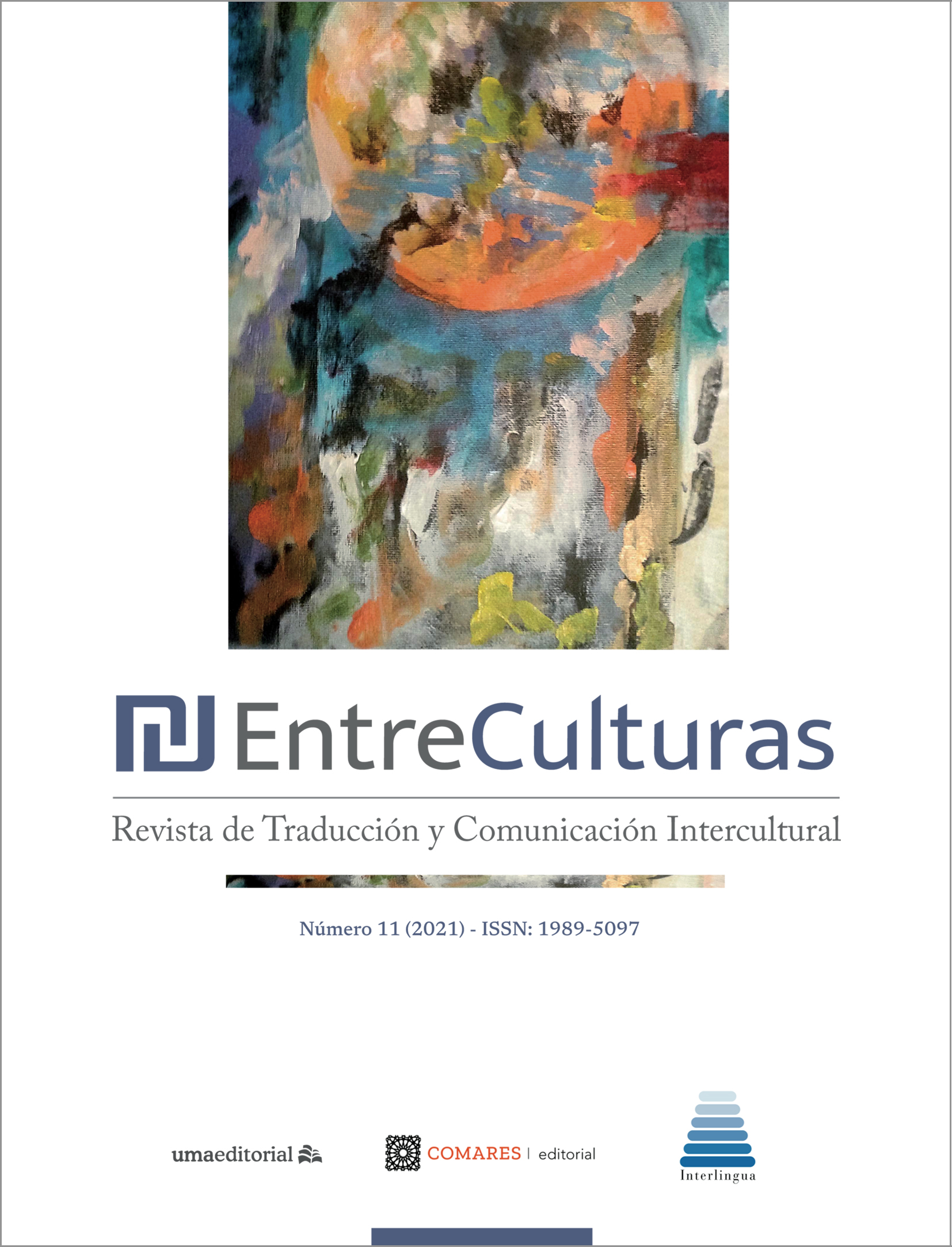The (In)Translatability of the Audiovisual Prototext: Colour in Hero, by Zhang Yimou
DOI:
https://doi.org/10.24310/Entreculturasertci.v1i11.12106Keywords:
audiovisual translation (TAV), connoted value of colors, semiotic information, extralinguistic contextAbstract
The images and colours are an inherent part of cinema and are at the same time a narrative prototext that is usually assumed as a lingua franca in audiovisual translation (TAV). However, each linguistic community may decode this semiotic information differently depending on the present ideology in their language.
Zhang Yimou's movie Hero gives special importance of colours. Therefore, we make a comparison of the connotations of the colours black, red and blue to investigate whether the difference in the perception of colours causes asymmetries in the information received by the audience in the original and translated versions in this case. From the symbology and the connoted values of the colours, we’ll discover that to what extent the translation is associated with a loss, addition or alteration of meaning, and how this process affects the reception of the film by the audience of the target language.
Downloads
Metrics
References
Bi Yifei (???) (2015): “Lun secai zai yingshi zuopin zhong de zhongyao zuoyong (??????????????)” [Las funciones importantes de los colores en las obras audiovisuales], Zhongguo lunwen wang (?????). [En línea] http://www.xzbu.com/7/view-6099908.htm [consulta: 20 de marzo de 2016].
Burad, Viviana (2009): “Una teoría interpretativa para el binomio lengua de señas – lengua hablada”, Cultura-sorda. [En línea] https://cultura-sorda.org/wp-content/uploads/2015/03/Burad_teoria_interpretativa_binomio_lengua_senas_lengua_hablada_2009.pdf [consulta: 11 de octubre de 2015].
Chaume Varela, Frederic (2013): “Panorámica de la investigación en traducción para el doblaje”, REVISTA DE TRADUCTOLOGI?A, 17, 13-34. [En línea] http://www.trans.uma.es/trans_17/Trans17_013-034.pdf [consulta: 9 de diciembre de 2015].
Chaume Varela, Frederic (2005): “Los estándares de calidad y la recepción de la traducción audiovisual”, Puentes, 6, 5-12. [En línea] http://wdb.ugr.es/~greti/revista-puentes/pub6/01-Frederic-Chaume.pdf [consulta: 9 de diciembre de 2015].
Metz, Christian, traducido por Taylor, Michael (1968): Film Language: A Semiotics of the Cinema. Chicago, University of Chicago Press.
Delisle, Jean (1993): La traduction raisonnée. Manuel d’initiation à la traduction professsionnelle de l’anglais vers le français, Adaptación española de Bastin, Georges L. Caracas, Universidad Central de Venezuela.
Real Academia Española (2014): Diccionario de la lengua española, 23.ª ed. Barcelona, Espasa.
Hurtado Albir, Amparo (2001): Traducción y traductología: Introducción a la traductología. Madrid, Ediciones Cátedra.
Martínez Sierra, Juan José (2004): Estudio descriptivo y discursivo de la traducción del humor en textos audiovisuales. El caso de los Simpson. Universidad Jaume I, Servicio de Publicaciones de la Universidad Jaume I. [En línea] http://www.tdx.cat/bitstream/handle/10803/10566/martinez.pdf [consulta: 1 de noviembre de 2015].
Qian Shaochang (???) (2000): “Yingshi fanyi—fanyi yuandi zhong yu lai yu zhongyao de lingyu (????—?????????????)” [Traducción audiovisual——el dominio cada vez más importante en el ámbito de la traducción], Zhongguo fanyi (????), 1, 61-65.
Yang Heming (???) (2015): Xinhua Zidian (????) [Diccionario Xinhua]. Wuhan, Chongwen shuju (????).
Ye Jing (??) (2012): “Shixi dianying ‘yingxiong’ de secai yuyan de Yingyong (????????????????)” [El análisis de los colores en la película Hero], Dianying wenxue (????) (Movie Literature), 11, 142-143. [En línea] http://www.qb5200.com/content/2016-01-14/203559.html [consulta: 08/08/2017].
Zhang, Yimou (2004): Hero. Madrid, Sony Pict. H. Ent. & Cia., S.R.C.
Zhang, Yimou (2009): Hero. Madrid, Blu-ray.
Downloads
Published
How to Cite
Issue
Section
License
All contents published in Entre culturas. Revista de traducción y comunicación intercultural are protected under the Creative Commons Attribution-NonCommercial-ShareAlike 4.0 International (CC BY-NC-SA 4.0) license. All about this license is available in the following link: <http://creativecommons.org/licenses/by-nc-sa/4.0>
Users can copy, use, redistribute, share and exhibit publicly as long as:
- The original source and authorship of the material are cited (Journal, Publisher and URL of the work).
- It is not used for comercial purposes.
- The existence of the license and its especifications are mentioned.
There are two sets of authors’ rights: moral and property rights. Moral rights are perpetual prerogatives, unrenounceable, not-transferable, unalienable, imprescriptible and inembargable. According to authors’ rights legislation, Entreculturas. Revista de traducción y comunicación intercultural recognizes and respects authors moral rights, as well as the ownership of property rights, which will be transferred to University of Malaga in open access. The property rights are referred to the benefits that are gained by the use or the dissemination of works. Entreculturas. Revista de traducción y comunicación intercultural is published in an open access form and it is exclusively licenced by any means for doing or authorising distribution, dissemination, reproduction, , adaptation, translation or arrangement of works.
Authors are responsable for obtaining the necessary permission to use copyrighted images.





7.png)
